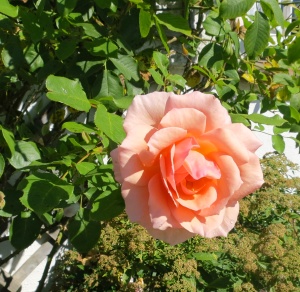Last night, with Giles, Jean, another Jackie, and Paul, we were entertained, first by Windmill Swing Band, at Milford on Sea Community Centre. This was an interesting experience. It was difficult for me, with my untrained ear, quite to decipher what we were hearing. The female singer had a powerful voice and performed very well, but was rather obscured by the number of instruments on and overflowing from the small stage. Of the sixteen accompanists, ten were saxophonists.
After the break came the Sugar Rush. Quite the most outstanding wind player, guesting as soloist for Windmill in the first session, turned out to be one of a quartet forming this second group. He played saxophones, clarinet, and flute. He was one of two Marks, the other playing keyboard. Two excellent, lively, and entertaining female singers made up the four. Given the option to leave during the brief interval in their performance, we declined, because we were enjoying them so much.
Giles, being rather partial to the flute, called out for more of this instrument and was rewarded with a melodic solo. So were the rest of us.
This morning Benjamin of Abre Electrical came on time and thoroughly investigated our problems. The fault seems to be under the kitchen tiles, with which we will not interfere. We cannot use the power points in a kitchen cupboard until a feed is drawn from upstairs, and we need a new fusebox.
We experienced more steady rain, which by the afternoon had stopped. The last push on the previously invisible path was a joint one.

We began with Jackie riddling, with a sieve, the earth I dug out of the track, to gather what gravel and impacted sand was still present. That was soon given up as pointless and Jackie, who now shared my job, and I tossed each spadeful, complete with stones, into the crowded shrubberies. That should help keep the weeds down, and we will probably be digging out gravel and chucking it piecemeal back onto the path for some time to come.
As will be apparent from the picture of Jackie at her initial task, there was far more soil than gravel on the path. This meant we had not bought enough stones, given that we now had to re-cover the whole area. After lunch, therefore, we took another trip to Ferndene Farm Shop and returned with five more bags of them.
In Everton Road a little boy of about six years old gave himself a nasty shock. On his bicycle, he sped out from between two oncoming cars he was trying to avoid, turned and rode straight at us, forcing Jackie to make an emergency stop. Terror was written all over his face. A few yards further on we decided to turn back and see if he was all right. By the time Jackie had found a suitable turning space and backtracked, he had disappeared. We rather hoped he was trembling on his mother’s knee.
Back home, we completed the laying down of the stones, and raked and swept them. Jackie added the finishing touch of six varied heucheras. Just as I finished photographing our achievement, the rain returned.
I call this the Heligan path, after the famous lost gardens of that name in Cornwall, because we really didn’t know it was there.
Several new roses are in bloom. Here is one:

And an iris.
This evening we dined on Moroccan roast lamb, pilau cous-cous complete with chilli, and carrots and green beans, followed by apple strudel. I drank a Langedoc reserve 2012.


























